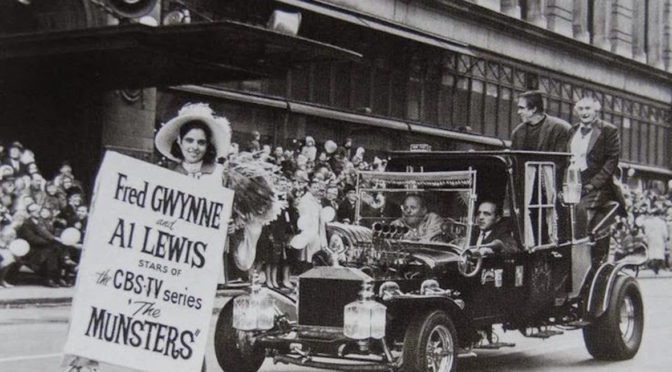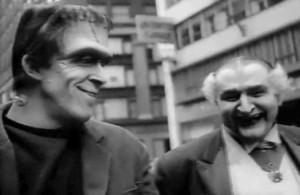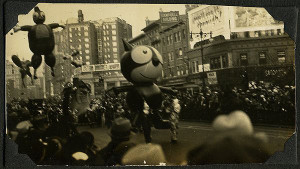Beautiful monsters: The stars of The Munsters are predictably not on their best behavior during the Macy’s Thanksgiving Day parade of 1964 (Photo courtesy Frankensteinia)
Macy’s Thanksgiving Day Parade is a fixture of the American holiday, as integral as the elements which comprise a standard turkey dinner. Don’t you get in the mood the moment you turn on the TV and hear the sound of marching bands echoing through the corridor of buildings on Broadway?
Since the parade’s debut in 1924, it has helped define Thanksgiving tradition for many people despite touching only occasionally on the whole point of the holiday itself. These days, you are far more likely to see a musical number from ‘Annie’ than a frank depiction of early Puritan life.
But in letting the show into your home — inviting in the floats and balloons, the falloons and the balloonicles, the never ending procession of clowns — you’re also inviting in a blistering microcosm of celebrities that have slowly come to define the event’s jovial interworkings. What was once a simple and earnest celebration by regular Macy’s employees in 1924 is now an event whereby any float can contain any number of unrelated celebrities, in most cases lip syncing to a pre-recorded Christmas track.
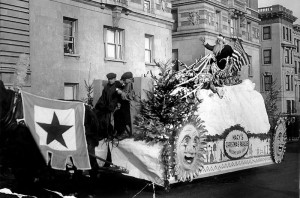
Santa, on his first Macy’s float, in 1924 (pic courtesy Smithsonion)
The Early Years
The first parade in 1924 was a labor of love, with employees in gaily colored costumes accompanied by four marching bands, a live animal procession, and modest floats celebrating a host of nursery rhymes figures. The only celebrities were some notable animals borrowed from the Central Park Zoo — this potentially bad idea was scrapped when the balloons came — and Santa Claus, who arrived in Herald Square to unveil the Christmas windows.
The inflatable balloons debuted in 1927, and along with the nameless dinosaur and dachshund floatables came Felix the Cat, the art-deco feline who had received his own comic strip four years previous. This would make Felix the first non-Macy’s related celebrity (albeit a drawn one) to appear in the parade with something to promote.
Nobody was really paying attention to the humans below, especially in the days before television. Perhaps that’s why the first human celebrities were accompanied by balloon versions of themselves. Eddie Cantor, who made his first parade appearance in 1935, was a comic song-and-dance man who had appeared in the Ziegfeld Follies and strummed along in silly, Hollywood toe-tappers like ‘Kid Millions’ and ‘Ali Baba Goes To Town’.
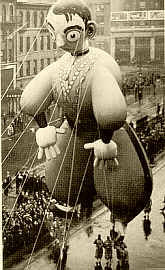 In 1940, Cantor made another appearance, in person and, this time, in balloon form (at right). He might have been using the parade to bolster his reputation. The year previous, Cantor had criticized the rants of Hitler sympathizer and Catholic priest Father Charles Edward Coughlin and lost his endorsement deal with Camel cigarettes in the process. It seems that criticizing a priest (even an anti-Semitic one) was not a boost professionally. The parade (and famous friends like Jack Benny) helped resuscitate his career.
In 1940, Cantor made another appearance, in person and, this time, in balloon form (at right). He might have been using the parade to bolster his reputation. The year previous, Cantor had criticized the rants of Hitler sympathizer and Catholic priest Father Charles Edward Coughlin and lost his endorsement deal with Camel cigarettes in the process. It seems that criticizing a priest (even an anti-Semitic one) was not a boost professionally. The parade (and famous friends like Jack Benny) helped resuscitate his career.
It was quite hard to compete with balloons if you were a star. The performances of Eddy Duchin and Dinah Shore were broadcast on the radio, and band leaders like Paul Whiteman and Kay Kyser led their orchestras at the parade’s finish line in Herald Square. But a few celebrities actually braved the parade itself, such as comedian Harpo Marx. In the days before cameras, most of the crowd would never know these famous folk were there, although in 1935 the zany Harpo climbed atop the Macy’s marquee to get noticed. Harpo also brought along a balloon in his likeness, carried along by Macy’s employees dressed like the other Marx Brothers.
Sadly, neither Marx nor Cantor are featured in this newsreel film from 1935:
One of the most notable celebrity appearances in the 1940s was done in disguise. Edmund Gwenn, who played Kris Kringle in the classic ‘Miracle on 34th Street’, a film set partially in Macy’s department store, dressed as Santa Claus for the 1946 event. Footage of his appearance was used in the film; most of the audience was none the wiser. Gwenn would go on to win an Oscar for that role.
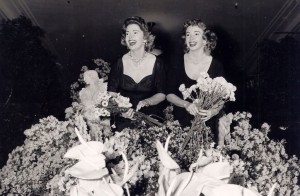 Audrey and Jayne Meadows atop a lavish float, probably 1952 (photo courtesy Macys)
Audrey and Jayne Meadows atop a lavish float, probably 1952 (photo courtesy Macys)
The Debut of Television
The first television broadcast, believe it or not, was in 1939, from a camera mounted atop the American Museum of Natural History. Of course, few had televisions to watch it, and it was shown only locally. But in the years following World War II, America embraced television, and television embraced the parade. CBS would take the first crack at broadcasting the extravaganza nationwide in 1952. NBC took over in 1955.
With cameras come celebrities, and they came in droves in the 1950s. Shirley Temple, well into her 20s, graced the parade, as did Jimmy Durante, Abbott and Costello, Roy Rogers and Dale Evans, Boris Karloff, and arguably one of television’s biggest stars Jackie Gleason, who was grand marshal in 1952.
That year was the debut of Jackie Gleason’s eponymous show on CBS — his TV wife Audrey Meadows also stopped by (see above) — and the comedian’s appearance opened the floodgate for a new breed of small-screen stars that used the parade to cross-promote new projects debuting on the very box broadcasting the parade into American homes.
Danny Kaye, Howdy Doody, Hopalong Cassidy, even the Lone Ranger and Tonto, all made appearances in the parade. The first TV celebrities were clearly those that appealed to children, the key audience of a morning program that featured large buoyant cartoon characters and floats. But that distinction would soon be blurred as the parade began reaching adults as well.
As the volume of celebrities increased, they became embedded in floating dioramas. That wasn’t just Cinderella waving at you; that was Connie Francis dressed as Cinderella, in 1959.
Stars of the Small Screen
In 1961, NBC made the critical decision to expand coverage to two hours. By the end of the decade, the entire parade was broadcast, from start to finish. With all this time to fill — and broadcast technology advanced enough to comfortably record live outdoors — the floodgates opened and a phalanx of small-time stars filled the parade route.
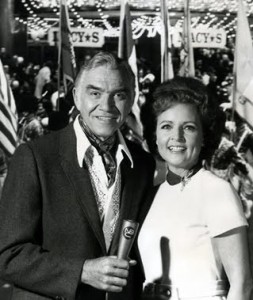 Key in this invasion was NBC’s presentation of the event. The parade was hosted in the 1960s by Bonanza star Lorne Greene and an attractive young comedienne by the name of Betty White (at right). Both achieved their fame from television work, not film. There was little fear that the big stars of that other world (the movies) would spill into frame. Parade entertainment would be gleaned from other places — TV shows, Broadway musicals, cabaret lounges. Even old radio and vaudeville stars would be dusted off and given a go.
Key in this invasion was NBC’s presentation of the event. The parade was hosted in the 1960s by Bonanza star Lorne Greene and an attractive young comedienne by the name of Betty White (at right). Both achieved their fame from television work, not film. There was little fear that the big stars of that other world (the movies) would spill into frame. Parade entertainment would be gleaned from other places — TV shows, Broadway musicals, cabaret lounges. Even old radio and vaudeville stars would be dusted off and given a go.
In the early 1960s alone, the parade featured such luminaries as Ray Bolger, Gene Krupa, Mitch Miller, Jack Palance, Troy Donahue, Annette Funicello and Greene’s young co-star Michael Landon. Young and old stars, mingling among the clowns, mugging for the cameras.
The stars were mostly well-behaved, with some notable exceptions. Fred Gwynne and Al Lewis, stars of The Munsters, appeared in the 1964 parade in their ghoulish costumes, riding along in their ‘Munster Koach’ car. Neither star was very amused. Gwynne was high on ‘nerve medicine’ and began cursing at the crowd. Passing the hosts Greene and White in the media box, Herman Munster fired off a rude expletive in their direction.
The video below captures them in a more sober mood:
Another trend manifested in 1965, when the fledgling McDonalds restaurant opted to sponsor the parade and debut its new mascot on national television — Ronald McDonald. (The man who regularly performed as Ronald — Willard Scott — was not used for the TV debut, which is unfortunate, as Scott would return as host of the parade in the late 1980s.)
Parade goers could greet William Shatner, star of Star Trek, in 1968, and Neil Armstrong, star of an actual space adventure, in 1969. Music, for the most part, was still saccharine, performed by artists like Jack Greene, Bobby Vinton and Dionne Warwick. Although Aretha Franklin brought a bit of soul on her own personal float in 1967.
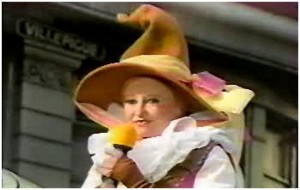 Phyllis Diller as Mother Goose, 1985. Photo courtesy X Entertainment
Phyllis Diller as Mother Goose, 1985. Photo courtesy X Entertainment
The Advent of the Super Float
Encouraging celebrity appearances perhaps even more than NBC was the debut of flashy, blockbuster floats into the parade in 1969. Before this, decorative vehicles and floats of modest proportion were interspersed among the bands and balloons. In 1969, parade designer Manfred Bass began construction of giant floats at the Parade Studio in Hoboken — elaborate, multi-staged platforms requiring multiple performers and specifically created to be showcased for television. To that end, these newly introduced floats made ideal platforms to display even more celebrity entertainment.
By the 1970s, television had produced hordes of stars, and the parade became a virtual Hollywood Squares of B-list talents. If you were a sitcom star of the 70s and 80s, it’s possible you were even contractually required to make an appearance. Making this doubly appealing for NBC and parade organizers was the possibility of float sponsorship by third-party products, such as Ocean Spray, who produced a Cranberry themed float and randomly threw ‘Buck Rogers In The 25th Century’ hunk Gil Gerard upon it for good measure.
The biggest television stars of 1976, Laverne and Shirley’s Penny Marshall and Cindy Williams, made a splash in their first appearance that year. According to Williams, “Suddenly there was all this screaming. We looked around to see who they were carrying on about, and it was us!”
The cultural changes of the ’70s hit the parade full force. Early in the decade, lite pop performers like the Fifth Dimension engaged the crowd. But the rising popularity of ’70s country music with pop overtones delivered notable performances, including George Jones and Tammy Wynette singing “We’re Gonna Hold On†in 1973, and a young Dolly Parton bringing “Love Like A Butterfly in 1974.
And then there was disco. Borne of decadent nightclubs that could be found just a few blocks from the parade, disco music slithered from the dance floor into the sunlight, walked upright and became mainstream in the mid-1970s. This would explain the appearances of Gloria Gaynor singing you-know-what-song in 1977 atop a Doodle Bug float, and a vibrant performance by the Village People in 1978. The following year, Diana Ross rode a gigantic apple while wrapped in a fur coat.
But the musical genre of choice was and continues to be Broadway, and further broadcast sophistication allowed whole production numbers to be presented. Perhaps the most unusual of all came in 1980, when the unorthodox Public Theater production of ‘The Pirates of Penzance’, starring later Solid Gold host Rex Smith and Linda Rondstadt.
The clip below also underscores the disastrous relationship such performances have with the television requirement to lip sync:
The Surreal Show
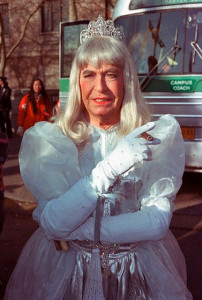 By the 1980s and 1990s, the parade broadcast has become a full-fledged beast of absurdity, a colorful swath of product placement, celebrity promotional events, and bleached out entertainment. Now it was the balloons and the marching bands’ turn to compete with the increasingly over-the-top celebrity appearances and elaborate Broadway routines, now bolstered with dated camera effects, such as the ones demonstrated in this 1981 performance by Donny Osmond (click here to view).
By the 1980s and 1990s, the parade broadcast has become a full-fledged beast of absurdity, a colorful swath of product placement, celebrity promotional events, and bleached out entertainment. Now it was the balloons and the marching bands’ turn to compete with the increasingly over-the-top celebrity appearances and elaborate Broadway routines, now bolstered with dated camera effects, such as the ones demonstrated in this 1981 performance by Donny Osmond (click here to view).
Further staged combinations hurled the proceedings into the land of the nonsensical. What was going through the mind of Broadway star and pop singer Melba Moore when she was asked to perform a hit by Bonnie Tyler while being accompanied by dancing, gyrating Marvel Comics characters in 1989?
It was now possible to perform in the parade without even being there. Oh, to have beheld the faces of children as they turned on the television sets in 1993 and witnessed this abstract performance by Chita Rivera from the show Kiss Of The Spider Woman:
Ultimately, what may have prevented the parade from degenerating into a pure mockery of its former self was the regular appearances of older, seasoned stars like Milton Berle (in drag, seen above), Sammy Davis Jr, and Phyllis Diller garbed as Mother Goose, in 1986.
As a counterpoint to old Hollywood, music artists popular with the parade’s core audience were interspersed to keep the proceedings relevant. Chief among these acts were boy bands like N Sync and the Backstreet Boys and, performing a few years earlier, their precursor, New Kids On the Block, in 1989:
Gone were the rational and linear selection of big band and film celebrities of the 1930s and 40s. Sixty years after Harpo Marx made his first appearance on the Macy’s marquee, in 1995, the parade welcomed a professional grab-bag of entertainers — LL Cool J, Brady Bunch maid Ann B. Davis, Shari Lewis and Lambchop, skating diva Oksana Baiul, country star Shania Twain, Kelsey Grammar, Matthew Broderick, Carol Channing, Stevie Wonder and the cast of Smokey Joe’s Cafe.
Never Can Say Goodbye: Gloria Gaynor makes another Macy’s Thanksgiving Day Parade appearance in 2009. Photo courtesy Day Life
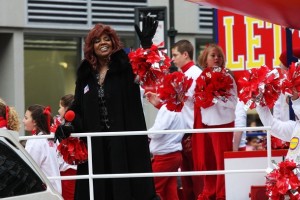
Today’s multi-million dollar procession is as chock-full of stars than ever before and is the only place on television where you can see, for example, British songbird Sarah Brightman and rapper Ne-Yo in the same place (as you could in 2007). Perhaps the key is to simply embrace the absurdity and take in the dizzying, mind-dulling array of entertainment like a virtual dose of strong coffee. And perhaps quietly note that the performers themselves recognize how odd everything seems, as referenced quite nicely in this performance from 2008, featuring the twisted stars of Foster’s Home For Imaginary Friends and a special musical guest:
Milton Berle photo courtesy Flickr/John McNab

